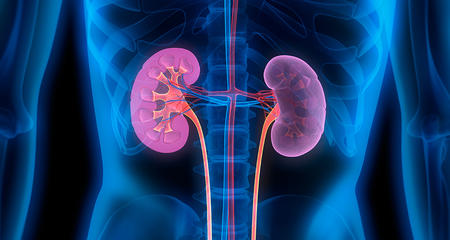Hypertension - or high blood pressure - affects millions of Americans. Endocrine hypertension is a subset of hypertension caused by hormone imbalance, most frequently involving the pituitary or adrenal gland. Patients who develop hypertension before the age of 30 who have a strong family history of hypertension, adrenal tumors, or develop a low potassium level (hypokalemia) should be screened for endocrine hypertension. Patients who have poor blood pressure control despite taking three or more blood pressure medications (resistant hypertension) should also be screened.
Endocrine Hypertension Disorders
Endocrine hypertension can be caused when glands produce too much or not enough hormone, or when they are affected by tumors.
Primary Aldosteronism
The most common form of endocrine hypertension, primary aldosteronism affects an estimated 5 percent to 10 percent of all patients with hypertension and is often under diagnosed. Excessive aldosterone production by the adrenal glands leads to fluid retention, loss of potassium and hypertension. If untreated, hyperaldosteronism may cause an enlarged heart.
Primary aldosteronism is diagnosed through blood and urine tests, and a CT scan of the adrenal glands. In some cases, adrenal vein sampling may be necessary to help differentiate the cause of the primary aldosteronism.
Forms of the disorder include:
- Conn's syndrome — a common subtype caused by a single adrenal tumor. Surgery to remove the tumor is an effective treatment.
- Bilateral adrenal hyperplasia — a common subtype caused by enlarged adrenal glands. This disorder is best treated with medications such as spironolactone and eplerenone.
- Primary adrenal hyperplasia — a rare subtype in which only one gland is enlarged. Surgery is the preferred treatment.
- Glucocorticoid remediable aldosteronism (GRA) — a rare subtype caused by a genetic mutation, often occurring in many family members.
- Familial hyperaldosteronism — a rare subtype in which about half of each generation develops hyperaldosteronism.
Cushing’s Syndrome
Cushing's syndrome occurs when too much cortisol is produced by the adrenal glands. People with Cushing’s syndrome often have other endocrine-related disorders, including diabetes, obesity, hypertension, kidney stones and osteoporosis. Many patients also suffer from depression.
Pheochromocytoma
Pheochromocytoma is a rare syndrome caused by tumors of the adrenal glands. These tumors produce excessive amounts of adrenaline, noradrenaline or other catecholamines. Though rare, patients with adrenal tumors should be tested for pheochromocytoma as about 10 percent of tumors are malignant.
Common symptoms are sweating, palpitations and headache, though patients can also have many other symptoms. Patients with a pheochromocytoma may have episodic or sustained hypertension. Some patients experience very high blood pressure readings known as hypertensive crisis, which is a medical emergency.
One in 10 people with pheochromocytoma has tumors located outside the adrenal glands. These extra-adrenal pheochromocytomas are also known as paragangliomas.
Another 10 percent of pheochromocytomas are part of multiple endocrine neoplasia syndromes (MEN syndrome I or II) which are genetic conditions that run in families. MEN syndromes can involve other endocrine organs such as the parathyroid glands, the pituitary, thyroid as well as other organs such as the kidney, pancreas or stomach.
Acromegaly
Acromegaly is a tumor of the pituitary gland that leads to excess growth hormone. Symptoms include joint and muscle problems, headache and vision problems. Affected patients tend to have very large hands, feet and tongue, and a prominent jaw. They can develop hypertension and diabetes.
Hyperthyroidism or Hypothyroidism
These disorders, if severe and untreated, can be associated with elevated blood pressure. Treatment of the thyroid disorder usually lowers the blood pressure to normal.
Other Causes of Endocrine Hypertension and Related Syndromes:
- Pseudohypoaldosteronism type 2 (Gordon’s syndrome) — patients develop hypertension and have high potassium levels (hyperkalemia)
- Liddle’s syndrome — a rare genetic form of hypertension in which patients have very low levels of aldosterone (pseudoaldosteronism)
- Apparent mineralocorticoid excess (AME) — a rare genetic form of hypertension
- Licorice ingestion — high blood pressure and low potassium triggered by eating licorice (usually black).
- Bartter’s syndrome — detected in infancy or childhood with symptoms of severe low potassium (hypokalemia) and other birth defects. No associated hypertension.
- Gitelman’s syndrome — milder form of hypokalemia occurring in young adults, often with low magnesium levels as well. No associated hypertension.
Blogs, Patient Stories, Videos and Classes





